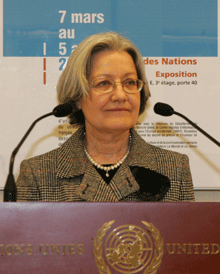
The Palais des Nations has been fortunate enough to host a unique exhibition of eighteen world-famous cartoonists, ranging from Plantu (France), Ranan Lurie (USA), Patrick Chappatte (Switzerland), Ali Dilem (Algeria), Hassan Karimzadeh (Iran), Michel Kichka (Israel), Stavro (Lebanon), Mikhail Zlatkovsky (Russia) and many others.
 Kofi Annan, former UN Secretary-General, was a great fan of political caricatures, and Ms Marie Heuze, Director of the United Nations Information Service in Geneva, introduced him to the famous French cartoonist Plantu many years ago. From there, the idea of cartoonists collaborating to spread the message of peace was born. The inspiration for the exhibition came from Plantu, whose cartoons are published in the well-known French newspaper Le Monde. However, without the efforts of the Department of Public Information and Ms Heuze, this exhibition would never have seen the light of day.
Kofi Annan, former UN Secretary-General, was a great fan of political caricatures, and Ms Marie Heuze, Director of the United Nations Information Service in Geneva, introduced him to the famous French cartoonist Plantu many years ago. From there, the idea of cartoonists collaborating to spread the message of peace was born. The inspiration for the exhibition came from Plantu, whose cartoons are published in the well-known French newspaper Le Monde. However, without the efforts of the Department of Public Information and Ms Heuze, this exhibition would never have seen the light of day.
The exhibition was first launched at the United Nations Headquarters in New York last year. Cartoons are key tools used by the press to communicate important messages. Not only do these works of art represent a political situation at a certain time, they also embody history — our history.
Pictures — and among them cartoons — speak louder than words. They do not need to be translated from one language to another to successfully convey a thought or a message. They have a unique ability to transcend language barriers, because each of us as individuals interprets these images according to our own way of life, value system, traditions and beliefs. However, while images may be as strong as words, or even stronger, they are not an alternative to constructive dialogue.
This exhibition is traveling to Paris and Brussels over the coming months, so if you missed the chance to see it in Geneva, perhaps you can see it there.



